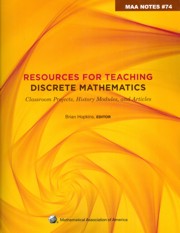Book contents
- Frontmatter
- Introduction
- Dedication
- Contents
- I Classroom-tested Projects
- The Game of “Take Away”
- Pile Splitting Problem: Introducing Strong Induction
- Generalizing Pascal: The Euler Triangles
- Coloring and Counting Rectangles on the Board
- Fun and Games with Squares and Planes
- Exploring Recursion with the Josephus Problem: (Or how to play “One Potato, Two Potato” for keeps)
- Using Trains to Model Recurrence Relations
- Codon Classes
- How to change coins, M&M's, or chicken nuggets: The linear Diophantine problem of Frobenius
- Calculator Activities for a Discrete Mathematics Course
- Bulgarian solitaire
- Can you make the geodesic dome?
- Exploring Polyhedra and Discovering Euler's Formula
- Further Explorations with the Towers of Hanoi
- The Two Color Theorem
- Counting Perfect Matchings and Benzenoids
- Exploring Data Compression via Binary Trees
- A Problem in Typography
- Graph Complexity
- II Historical Projects in Discrete Mathematics and Computer Science
- III Articles Extending Discrete Mathematics Content
- IV Articles on Discrete Mathematics Pedagogy
- About the Editor
Exploring Recursion with the Josephus Problem: (Or how to play “One Potato, Two Potato” for keeps)
from I - Classroom-tested Projects
- Frontmatter
- Introduction
- Dedication
- Contents
- I Classroom-tested Projects
- The Game of “Take Away”
- Pile Splitting Problem: Introducing Strong Induction
- Generalizing Pascal: The Euler Triangles
- Coloring and Counting Rectangles on the Board
- Fun and Games with Squares and Planes
- Exploring Recursion with the Josephus Problem: (Or how to play “One Potato, Two Potato” for keeps)
- Using Trains to Model Recurrence Relations
- Codon Classes
- How to change coins, M&M's, or chicken nuggets: The linear Diophantine problem of Frobenius
- Calculator Activities for a Discrete Mathematics Course
- Bulgarian solitaire
- Can you make the geodesic dome?
- Exploring Polyhedra and Discovering Euler's Formula
- Further Explorations with the Towers of Hanoi
- The Two Color Theorem
- Counting Perfect Matchings and Benzenoids
- Exploring Data Compression via Binary Trees
- A Problem in Typography
- Graph Complexity
- II Historical Projects in Discrete Mathematics and Computer Science
- III Articles Extending Discrete Mathematics Content
- IV Articles on Discrete Mathematics Pedagogy
- About the Editor
Summary
Summary
The Josephus problem is addressed in many discrete mathematics textbooks as an exercise in recursive modeling, with some books (e.g., [1] and [3]) even using it within the first few pages as an introductory problem to intrigue students. Since most students are familiar with the use of simple rhymes (like Eeny-meeny-miney-moe) for decision-making on the playground, they are comfortable with the physical process involved in this problem. For students who may wish to pursue this topic independently, [4] and [5] provide nice surveys and bibliographies, and the website [2] provides web-based tools for exploring the problem directly. The activities presented here are intended to be completed by students in a single class period early in the semester. We find that an opening student-centered problem can get the class involved and set a good tone for the semester. Moreover, we find that many issues arising from this particular problem can be built upon throughout the course. The next section provides some suggestions for connections to other parts of the course.
Notes for the instructor
The Josephus problem can be explored through role playing or through carefully constructed pencil and paper activities, depending on the amount of time one wishes to devote to it. We list below some of the things we discuss just before the activity as well as some of the contexts in which we have students revisit the problem later on.
- Type
- Chapter
- Information
- Resources for Teaching Discrete MathematicsClassroom Projects, History Modules, and Articles, pp. 45 - 54Publisher: Mathematical Association of AmericaPrint publication year: 2009



